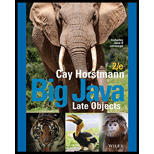
Big Java Late Objects
2nd Edition
ISBN: 9781119330455
Author: Horstmann
Publisher: WILEY
expand_more
expand_more
format_list_bulleted
Question
Chapter 18, Problem 4PP
Program Plan Intro
Finding largest element in an array list
Program plan:
Filename: “Measurable.java”
This code snippet creates an interface “Measurable”. In the code,
- Import the required packages.
- Define a class “Measurable”.
- Define the class member “getMeasure()”.
- Define the method “largest()”.
- If the size of the “objects” is equal to 0,
- Return a value “null”.
- Declare a variable “largest” and set its value.
- Iterate a “for” loop,
- If “obj” is less than “largest”,
- Set “largest” equal to “obj”.
- If “obj” is less than “largest”,
- Return “largest”.
- If the size of the “objects” is equal to 0,
Filename: “BankAccount.java”
This code snippet creates a class “BankAccount”. In the code,
- Define a class “BankAccount”.
- Define the class member “balance”.
- Define the constructor “BankAccount()”.
- Set the value of “balance”.
- Define the method “deposit()”.
- Set the value of “balance”.
- Define the method “withdraw()”.
- Set the value of “balance”.
- Define the method “getBalance()”.
- Return the value of “balance”.
- Define the method “getMeasure()”.
- Return the value of “balance”.
Filename: “Country.java”
This code snippet creates a class “Country”. In the code,
- Define a class “Country”.
- Define the class members “name” and “area”.
- Define the constructor “Country()”.
- Set the value of “name” and “area”.
- Define the method “getName()”.
- Return the value of “name”.
- Define the method “getArea()”.
- Return the value of “area”.
- Define the method “getMeasure()”.
- Return the value of “area”.
Filename: “MeasurableTester.java”
This code snippet creates a class “MeasurableTester”. In the code,
- Define a class “MeasurableTester”.
- Define the “main” method.
- Define an array list “accounts” and set the objects to it.
- Add elements to “accounts”.
- Call the method “largest()” and save the value to “largestAccount”.
- Call the method “getBalance()” and print the value.
- Print the expected value.
- Define an array list “contries” and set the objects to it.
- Add elements to “contries”.
- Call the method “largest()” and save the value to “largestCountry”.
- Call the method “getArea()” and print the value.
- Print the expected value.
- Call the method “getName()” and print the value.
- Print the expected value.
- Define the “main” method.
Expert Solution & Answer
Want to see the full answer?
Check out a sample textbook solution
Chapter 18 Solutions
Big Java Late Objects
Ch. 18.1 - Prob. 1SCCh. 18.1 - Prob. 2SCCh. 18.1 - Prob. 3SCCh. 18.1 - Prob. 4SCCh. 18.1 - Prob. 5SCCh. 18.2 - Prob. 6SCCh. 18.2 - Prob. 7SCCh. 18.2 - Prob. 8SCCh. 18.2 - Prob. 9SCCh. 18.2 - Prob. 10SC
Ch. 18.3 - Prob. 11SCCh. 18.3 - Prob. 12SCCh. 18.3 - Prob. 13SCCh. 18.3 - Prob. 14SCCh. 18.3 - Prob. 15SCCh. 18.4 - Prob. 16SCCh. 18.4 - Prob. 17SCCh. 18.4 - Prob. 18SCCh. 18.4 - Prob. 19SCCh. 18.4 - Prob. 20SCCh. 18.4 - Prob. 21SCCh. 18.5 - Prob. 22SCCh. 18.5 - Prob. 23SCCh. 18.5 - Prob. 24SCCh. 18.5 - Prob. 25SCCh. 18.5 - Prob. 26SCCh. 18.5 - Prob. 27SCCh. 18 - Prob. 1RECh. 18 - Prob. 2RECh. 18 - Prob. 3RECh. 18 - Prob. 4RECh. 18 - Prob. 5RECh. 18 - Prob. 6RECh. 18 - Prob. 7RECh. 18 - Prob. 8RECh. 18 - Prob. 9RECh. 18 - Prob. 10RECh. 18 - Prob. 11RECh. 18 - Prob. 12RECh. 18 - Prob. 13RECh. 18 - Prob. 14RECh. 18 - Prob. 1PECh. 18 - Prob. 2PECh. 18 - Prob. 3PECh. 18 - Prob. 4PECh. 18 - Prob. 5PECh. 18 - Prob. 6PECh. 18 - Prob. 7PECh. 18 - Prob. 8PECh. 18 - Prob. 9PECh. 18 - Prob. 10PECh. 18 - Prob. 11PECh. 18 - Prob. 12PECh. 18 - Prob. 13PECh. 18 - Prob. 14PECh. 18 - Prob. 15PECh. 18 - Prob. 16PECh. 18 - Prob. 17PECh. 18 - Prob. 18PECh. 18 - Prob. 19PECh. 18 - Prob. 20PECh. 18 - Prob. 21PECh. 18 - Prob. 22PECh. 18 - Prob. 1PPCh. 18 - Prob. 2PPCh. 18 - Prob. 3PPCh. 18 - Prob. 4PPCh. 18 - Prob. 5PPCh. 18 - Prob. 6PPCh. 18 - Prob. 7PPCh. 18 - Prob. 8PP
Knowledge Booster
Recommended textbooks for you
 Database System ConceptsComputer ScienceISBN:9780078022159Author:Abraham Silberschatz Professor, Henry F. Korth, S. SudarshanPublisher:McGraw-Hill Education
Database System ConceptsComputer ScienceISBN:9780078022159Author:Abraham Silberschatz Professor, Henry F. Korth, S. SudarshanPublisher:McGraw-Hill Education Starting Out with Python (4th Edition)Computer ScienceISBN:9780134444321Author:Tony GaddisPublisher:PEARSON
Starting Out with Python (4th Edition)Computer ScienceISBN:9780134444321Author:Tony GaddisPublisher:PEARSON Digital Fundamentals (11th Edition)Computer ScienceISBN:9780132737968Author:Thomas L. FloydPublisher:PEARSON
Digital Fundamentals (11th Edition)Computer ScienceISBN:9780132737968Author:Thomas L. FloydPublisher:PEARSON C How to Program (8th Edition)Computer ScienceISBN:9780133976892Author:Paul J. Deitel, Harvey DeitelPublisher:PEARSON
C How to Program (8th Edition)Computer ScienceISBN:9780133976892Author:Paul J. Deitel, Harvey DeitelPublisher:PEARSON Database Systems: Design, Implementation, & Manag...Computer ScienceISBN:9781337627900Author:Carlos Coronel, Steven MorrisPublisher:Cengage Learning
Database Systems: Design, Implementation, & Manag...Computer ScienceISBN:9781337627900Author:Carlos Coronel, Steven MorrisPublisher:Cengage Learning Programmable Logic ControllersComputer ScienceISBN:9780073373843Author:Frank D. PetruzellaPublisher:McGraw-Hill Education
Programmable Logic ControllersComputer ScienceISBN:9780073373843Author:Frank D. PetruzellaPublisher:McGraw-Hill Education

Database System Concepts
Computer Science
ISBN:9780078022159
Author:Abraham Silberschatz Professor, Henry F. Korth, S. Sudarshan
Publisher:McGraw-Hill Education

Starting Out with Python (4th Edition)
Computer Science
ISBN:9780134444321
Author:Tony Gaddis
Publisher:PEARSON

Digital Fundamentals (11th Edition)
Computer Science
ISBN:9780132737968
Author:Thomas L. Floyd
Publisher:PEARSON

C How to Program (8th Edition)
Computer Science
ISBN:9780133976892
Author:Paul J. Deitel, Harvey Deitel
Publisher:PEARSON

Database Systems: Design, Implementation, & Manag...
Computer Science
ISBN:9781337627900
Author:Carlos Coronel, Steven Morris
Publisher:Cengage Learning

Programmable Logic Controllers
Computer Science
ISBN:9780073373843
Author:Frank D. Petruzella
Publisher:McGraw-Hill Education